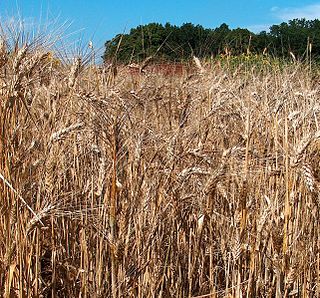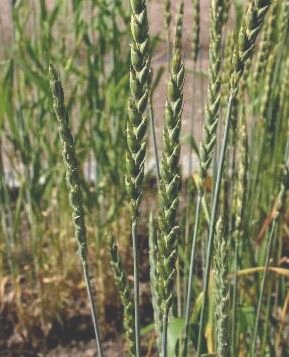
Wheat is a grass widely cultivated for its seed, a cereal grain that is a worldwide staple food. The many species of wheat together make up the genus Triticum ; the most widely grown is common wheat. The archaeological record suggests that wheat was first cultivated in the regions of the Fertile Crescent around 9600 BCE. Botanically, the wheat kernel is a type of fruit called a caryopsis.

Einkorn wheat can refer either to a wild species of wheat (Triticum) or to its domesticated form. The wild form is T. boeoticum, the domesticated form is T. monococcum. Einkorn is a diploid species of hulled wheat, with tough glumes ('husks') that tightly enclose the grains. The cultivated form is similar to the wild, except that the ear stays intact when ripe and the seeds are larger. The domestic form is known as "petit épeautre" in French, "Einkorn" in German, "einkorn" or "littlespelt" in English, "piccolo farro" in Italian and "escanda menor" in Spanish. The name refers to the fact that each spikelet contains only one grain.

Secale is a genus of the grass tribe Triticeae, which is related to barley (Hordeum) and wheat (Triticum). The genus includes cultivated species such as rye as well as weedy and wild rye species. The most well known species of the genus is the cultivated rye, S. cereale, which is grown as a grain and forage crop. Wild and weedy rye species help provide a huge gene pool that can be used for improvement of the cultivated rye.

Emmer wheat or hulled wheat is a type of awned wheat. Emmer is a tetraploid. The domesticated types are Triticum turgidum subsp. dicoccum and Triticum turgidum conv. durum. The wild plant is called Triticum turgidum subsp. dicoccoides. The principal difference between the wild and the domestic is that the ripened seed head of the wild plant shatters and scatters the seed onto the ground, while in the domesticated emmer the seed head remains intact, thus making it easier for humans to harvest the grain.

The mouflon is a wild sheep native to Cyprus, the Caspian region from eastern Turkey, Armenia, Azerbaijan, and Iran. It is thought to be the ancestor of all modern domestic sheep breeds.

Durum wheat, also called pasta wheat or macaroni wheat, is a tetraploid species of wheat. It is the second most cultivated species of wheat after common wheat, although it represents only 5% to 8% of global wheat production. It was developed by artificial selection of the domesticated emmer wheat strains formerly grown in Central Europe and the Near East around 7000 BC, which developed a naked, free-threshing form. Like emmer, durum wheat is awned. It is the predominant wheat that grows in the Middle East.

Spelt, also known as dinkel wheat or hulled wheat, is a species of wheat that has been cultivated since approximately 5000 BC.
Ararat or in Western Armenian Ararad may refer to:

Khorasan wheat or Oriental wheat, commercially known as Kamut, is a tetraploid wheat species. The grain is twice the size of modern-day wheat, and has a rich, nutty flavor.

The founder crops are the eight plant species that were domesticated by early Neolithic farming communities in Southwest Asia and went on to form the basis of agricultural economies across much of Eurasia, including Southwest Asia, South Asia, Europe, and North Africa. They consist of three cereals, four pulses, and flax. These species were amongst the first domesticated plants in the world.

Aegilops is a genus of Eurasian and North American plants in the grass family, Poaceae. They are known generally as goatgrasses. Some species are known as invasive weeds in parts of North America.

Common wheat, also known as bread wheat, is a cultivated wheat species. About 95% of wheat produced worldwide is common wheat; it is the most widely grown of all crops and the cereal with the highest monetary yield.

During 10,000 years of cultivation, numerous forms of wheat, many of them hybrids, have developed under a combination of artificial and natural selection. This diversity has led to much confusion in the naming of wheats. This article explains how genetic and morphological characteristics of wheat influence its classification, and gives the most common botanical names of wheat in current use. Information on the cultivation and uses of wheat is at the main wheat page.

Triticeae is a botanical tribe within the subfamily Pooideae of grasses that includes genera with many domesticated species. Major crop genera found in this tribe include wheat, barley, and rye; crops in other genera include some for human consumption, and others used for animal feed or rangeland protection. Among the world's cultivated species, this tribe has some of the most complex genetic histories. An example is bread wheat, which contains the genomes of three species with only one being a wheat Triticum species. Seed storage proteins in the Triticeae are implicated in various food allergies and intolerances.

Triticum timopheevii, Timopheev's wheat or Zanduri wheat, is a tetraploid wheat that has both cultivated and wild forms. It is believed to have evolved in isolation from the more common Triticum turgidum; hybrids between T. timopheevii and T. turgidum are reportedly sterile with "a considerable amount of chromosomal irregularities in meiosis."
Iraq ed-Dubb, or the Cave of the Bear, is an early Neolithic archeological site 7 km (4.3 mi) northwest of Ajlun in the Jordan Valley, in modern-day Jordan. The settlement existed before 8,000 BCE and experimented with the cultivation of founder crops, side by side with the harvesting of wild cereals. Along with Tell Aswad in Syria, the site shows the earliest reference to domestic hulled barley between 10,000 and 8,800 BCE. The site is located on a forested limestone escarpment above the Wadi el-Yabis in northwest Jordan. An oval-shaped stone structure was excavated along with two burials and a variety of animal and plant remains.

Triticum carthlicum Nevski, 1934, the Persian wheat, is a tetraploid wheat.

Triticum compactum or club wheat is a species of wheat adapted to low-humidity growing conditions. T. compactum is similar enough to common wheat that it is often considered a subspecies, T. aestivum compactum. It can be distinguished by its more compact ear due to shorter rachis segments, giving it its common name. In the United States of America, nearly all T. compactum is grown in dry areas of the Pacific Northwest.

Ancient grains is a marketing term used to describe a category of grains and pseudocereals that are purported to have been minimally changed by selective breeding over recent millennia, as opposed to more widespread cereals such as corn, rice and modern varieties of wheat, which are the product of thousands of years of selective breeding. Ancient grains are often marketed as being more nutritious than modern grains, though their health benefits over modern varieties have been disputed by some nutritionists.

Iris iberica subsp. elegantissima is a subspecies in the genus Iris, subgenus Iris and section Oncocyclus. It is a subspecies of Iris iberica and is a rhizomatous perennial, from Armenia, Turkey and Iran. It has large, thin and falcate (sickle-shaped) leaves, slender stem with a single flower between April and May. It has a white, cream or pale yellow ground, which is covered in dark veining or speckling in violet, mauve, purple or brown shades. The larger standards are paler, normally white and less veined. The falls, have darker veining and a dark signal patch and brown or purple beard. It is commonly known as Iris elegantissima, especially in Europe and Russia. It is cultivated as an ornamental plant in temperate regions, but normally needs some protection during the winter period.

















